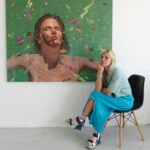Unmasking Identity

Evgen Čopi Gorišek explores the interplay between vibrant art and the complexities of human emotion in contemporary society
Evgen Čopi Gorišek discusses his artistic journey, the influence of pop art masters, and the emotional depth behind his captivating portraits.
Evgen Čopi Gorišek stands out in the contemporary art scene for his ability to weave vibrant aesthetics with thought-provoking themes. His striking portraits, marked by a playful yet poignant use of color and form, delve into the intricacies of identity and emotional expression in today’s digital age. Gorišek’s signature style juxtaposes intricately painted skin with simplified, smiling faces, encouraging viewers to reflect on the masks people wear in their everyday lives. Each piece serves as a visual delight and a compelling commentary on the complexities of human connection and the often superficial nature of social interactions.
In our conversation, Gorišek shares the inspiration he drew from iconic pop art masters and how that pivotal experience shaped his artistic vision. He explores the innovative techniques that define his work, the depth behind his uniform smiles, and the intersection of his art with contemporary culture and social media. This dialogue invites us to engage with Gorišek’s creations on a deeper level, encouraging a personal exploration of the narratives hidden within his vibrant canvases.
Gorišek masterfully combines vivid aesthetics with profound themes, inviting viewers to engage with the emotional complexities of identity and connection.
What inspired you to pursue a career in art after visiting the exhibition by pop art masters, and how did that experience shape your artistic vision?
It was for the first time in my life that I’ve seen masterpieces by pop artists in person. During this show they were projecting movies in the evening at the museum where I’ve discovered Jean Michel Basquiat documentary and many other Andy Warhol movies that as an 17 years old student blew me away. I immediately knew that I want to pursue career as an artist.
It definitely left at that time a strong impact on my work and inspiration. I was experimenting a lot on different approaches like the other pop art masters did and the main direction was inspired by Basquiat that also drew me forward for many years in that direction.
Can you explain your artistic approach, particularly how you developed the contrasting styles of depicting faces and bodies in your portraits?
After discovering airbrush, it opened so many new doors on how to approach on the canvas and so many new possibilities on what is possible to make. Obviously it took me quite some to to get used to it and to explore its potential and learn the skills.
While trying all of this, always painting faces already before that by playing around and trying to simplify things it just happened to cane across the “smiley” faces that at the beginning were a bit different and with time I developed them into what I still use today.
While learning how to paint the skin, I just didn’t wanted to make the face as precise and detailed as I did with the skin, so with searching of contrast between detailed skin and simple unique face this combination worked perfectly together.
How do you think the uniform smiles in your portraits reflect the themes of communication and connection in contemporary society?
In a way reminds me many times of a emojis that are used very frequently in our society, and secondly my faces are very repetitive as most of communications are.
In what ways do you feel your use of oil sticks and acrylics enhances the messages you’re conveying in your artwork?
I have never connected or thought about materials or media that I use with the messages conveying in my work. I just love using as many different techniques possible and experimenting with them. Oil stick in particular I like to use because of its texture that it gives and this is one of the very important parts in my work. Searching for contrasts and textures trying to combine them in a perfect blend together.
How do you see your work interacting with the culture of social media and the polished images it promotes?
I think it fitted very well in. Mostly because the images from which I work with on those paintings are taken from social media and magazines that I recreate digitally and after paint on the canvases.
What message or feeling do you hope viewers take away from your artwork, particularly in relation to the themes of identity and superficiality?
I always say that for me the best thing is if every viewer interprets his own story or vision watching my work.
As I said many times when asked regarding those repeating smiley faces. They are also having an symbolic meaning of masks hiding feelings behind it.
so many people smile in front of others, but at the same time hiding some sad, angry or anxious feelings and thoughts that they don’t want to expose. So this is why I like to leave viewers to made their own story and feelings about the person that is painted on the canvas.
EDITOR’S HIGHLIGHTS
Empowering Art & Artists Globally
“Being featured in WOWwART means gaining visibility not just in print edition, but across the entire media spectrum in the US, UK, Europe and beyond”

EDITOR’S HIGHLIGHTS
Media, Art and Artist
Media is a powerful tool to build relationships, boost visibility, influence decisions, and create lasting impressions for success and growth.













